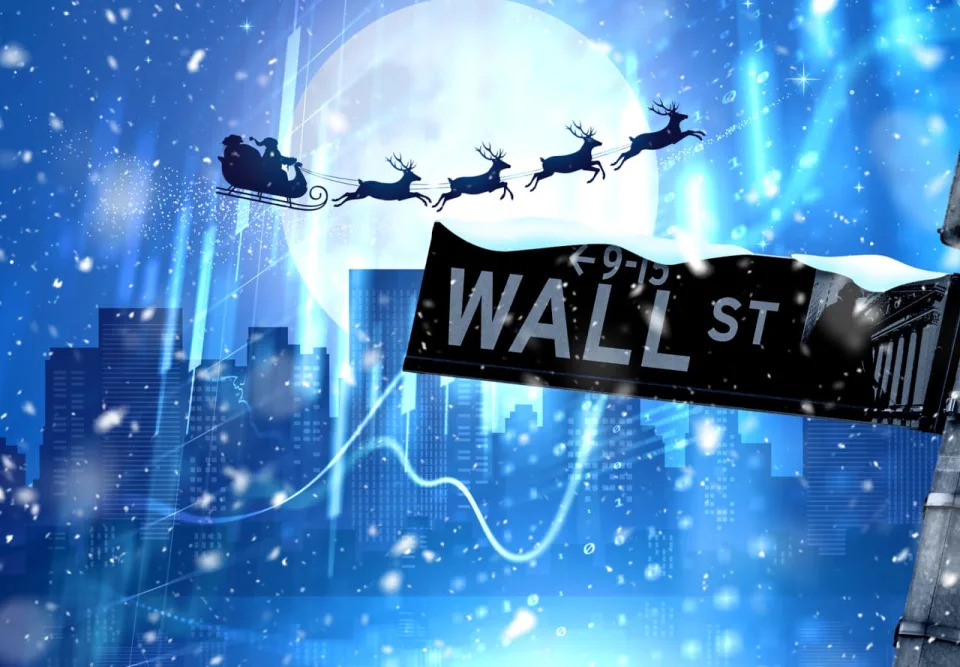News
Wall Street’s ‘Santa Claus rally’ window is about to open with the Dow down in December

Stocks have struggled ahead of the holidays despite Friday’s rally.
An “almost light-switch moment” at the start of December sparked a “breakdown in breadth” this month in the U.S. stock market, following a strong rally in November, said Mark Hackett, chief market strategist at Nationwide, in a phone interview.
“I don’t feel comfortable that the traditional ‘Santa Claus rally’ is going to come,” he said, “simply because I think you might have already fast-forwarded that in November.”
The Dow Jones Industrial Average DJIA has wiped out most of its gains so far this quarter, after a 4.6% loss in December through Friday. The S&P 500 SPX ended Friday with back-to-back weekly losses, while the Nasdaq Composite COMP snapped four straight weeks of gains, according to Dow Jones Market Data.
The stock market stumbled this past week after the Federal Reserve signaled a potentially smaller reduction in interest rates in 2025 than Fed officials previously projected. That took a bite out of the stock market’s big rally following the U.S. presidential election, with investors now worried about recent bad breadth in the top-heavy S&P 500 index and uncertainty about President-elect Donald Trump’s policies in 2025.
The S&P 500 is slumping ahead of a holiday trading stretch that historically tends to be positive for stocks, although, a year ago, investors hoping for a “Santa Claus rally” didn’t get one either.
This year, the traditional Santa Claus trading period will begin on Christmas Eve and run through Jan. 3. The seasonal stretch, when investors are looking for a so-called Santa rally, covers seven sessions including the last trading five days of December and the first two of the New Year.
Since 1950, the S&P 500 has gained an average of 1.29% during that Santa Claus trading stretch, ending higher 77% of the time, according to Dow Jones Market Data. But last year, the Santa rally didn’t show up, with the S&P 500 falling 0.9% during that seven-day run leading into 2024.
The U.S. stock market will be closed Christmas Day on Dec. 25 as well as on New Year’s Day.
Meanwhile, consumers seem to be having a “happy holiday season,” said economists at First Trust, in a note Friday on the latest data on personal income and consumption in November. “Strong income gains and healthy spending continued in November, while headline inflation took a breather.”
Fresh data Friday showed U.S. inflation in November, as measured by personal-consumption-expenditures price index, rose slightly less than Wall Street expected.
See: Surprise! Fed-favored inflation gauge shows slower price increases in November
The U.S. stock market bounced Friday as the softer-than-forecast inflation data sparked relief among investors anxious about its stickiness heading into 2025. Still, all three major equities benchmarks closed with weekly losses, failing to climb their way out of Wednesday’s slump.
On Friday, the Dow DJIA jumped 1.2%, booking its biggest gain since the day after the U.S. presidential election in early November, while the S&P 500 closed up 1.1% and the Nasdaq Composite COMP ended 1% higher.
For the week, though, the Dow was down 2.3%, the S&P 500 retreated 2% and the technology-heavy Nasdaq fell 1.8%. Big Tech stocks, which have an outsized weight in the S&P 500 and have propelled the index’s rally so far in 2024, had mixed weekly results after stumbling Wednesday.
The Roundhill Magnificent Seven ETF MAGS — which provides equal-weight exposure to seven closely watched Big Tech stocks including Apple Inc. AAPL, Microsoft Corp. MSFT, Google parent Alphabet Inc. GOOGL, Amazon.com Inc. AMZN, Nvidia Corp. NVDA, Tesla Inc. TSLA, and Facebook parent Meta Platforms Inc. META — finished Friday with a more than 1% weekly loss. The ETF snapped four straight weeks of gains that had added to its massive surge in 2024.
The “bump” in stocks spurred by the U.S. election has “round-tripped as investors went from focusing on deregulation and potential tax-cut tailwinds, to concerns about the Fed’s policy trajectory,” worries about sticky inflation and “a potential partial government shutdown,” analysts at Citigroup said in a research note Friday.
A partial U.S. government shutdown was looming over the market on Friday . However, the House and Senate rushed through final passage early Saturday of a bipartisan plan that would temporarily fund federal operations, dropping Trump’s demands for a government debt-limit increase into the new year.
Beyond government spending, investors will also be watching for details around new trade and immigration policies expected to emerge in 2025 under the next White House administration. Investors worry that more aggressive use of tariffs and mass deportations risk fueling a rise in inflation and hurting economic growth.
With 2024 winding down, both the Dow and S&P 500 on Friday were still mired in December losses despite an otherwise strong year.
“The average stock in the S&P 500 has really been weak for the entire month,” said Hackett.
The S&P 500 is down 1.7% so far in December, paring its fourth-quarter advance to 2.9%, according to FactSet data. The Dow was clinging to a smaller, 1.2% gain this quarter through Friday.
But the technology-heavy Nasdaq has fared better, with its 1.8% rise this month increasing its fourth-quarter jump to 7.6%.
“I don’t think we’re going to see a huge rally from now until the end of the year,” said Anthony Saglimbene, chief market strategist at Ameriprise Financial, in a phone interview.
After all, the Nasdaq has soared 30.4% in 2024 through Friday, while the S&P 500 has climbed 24.3% this year and the Dow has risen 13.7% year to date. The S&P 500 closed Friday 2.6% below its record closing high of 6,090.27 notched on Dec. 6, according to Dow Jones Market Data.
“There’s a lot of optimism already priced into stocks,” said Saglimbene. “We’ve had a really strong year in the market.”

